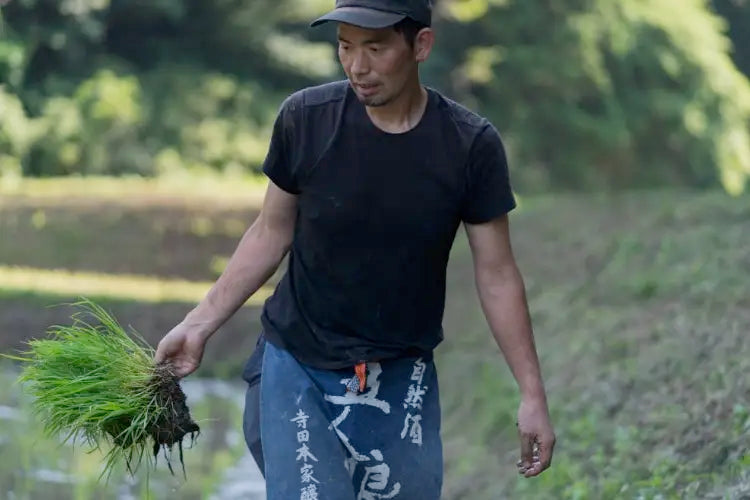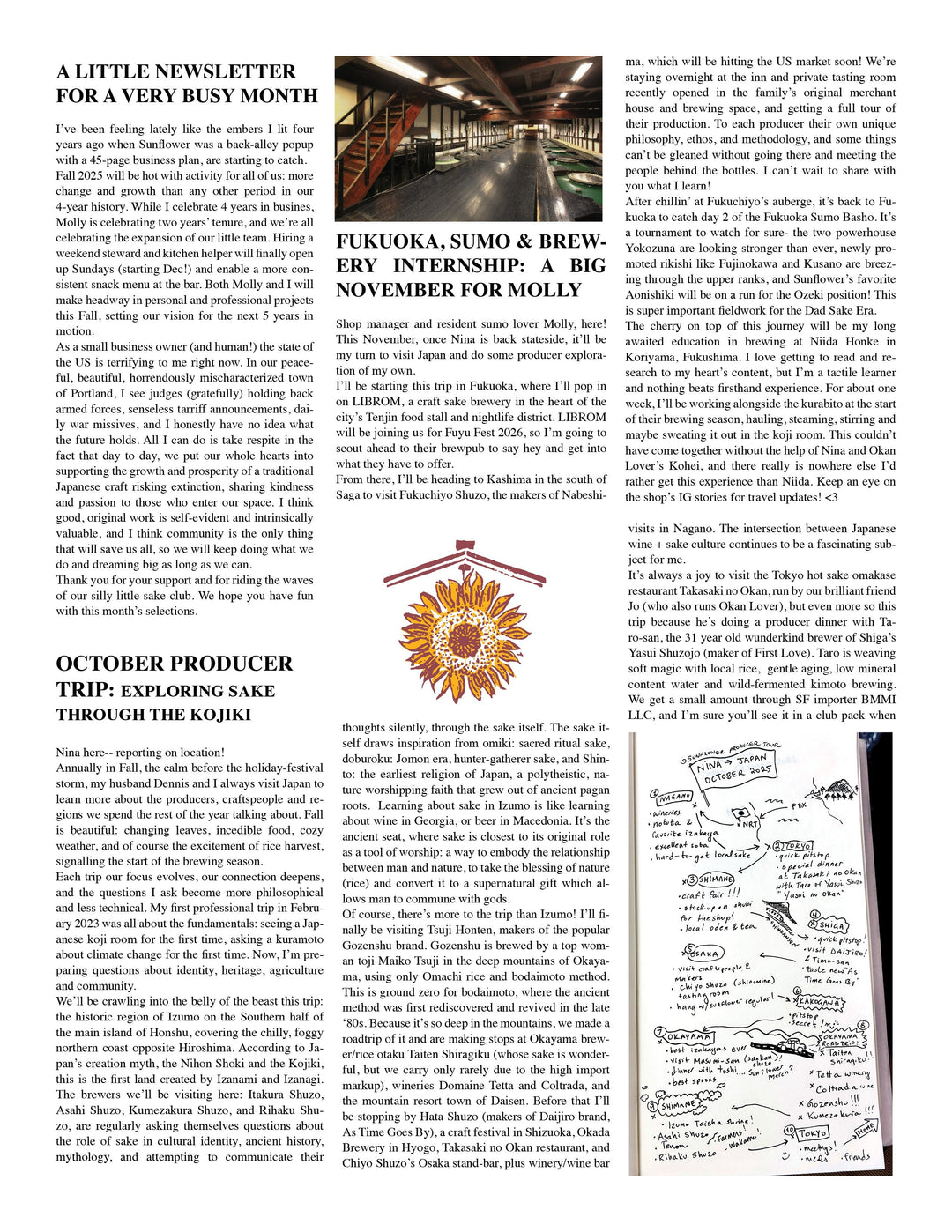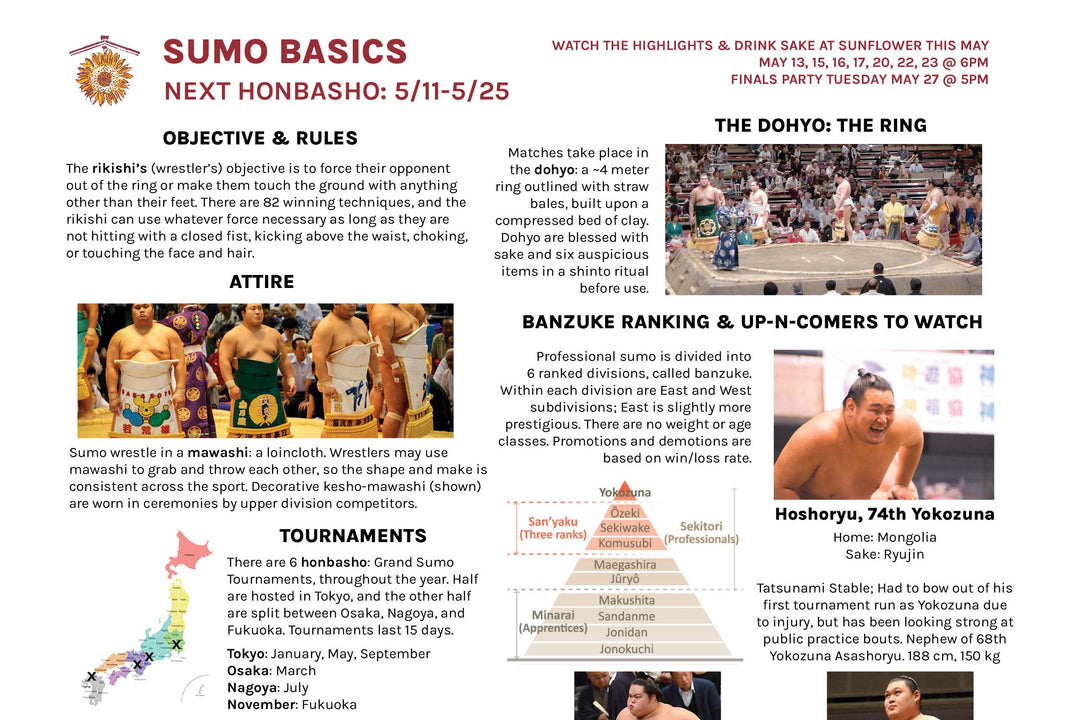APRIL 24: Terada Honke's Gonin Musume, three ways


Toji Masaru Terada preparing rice shoots for manual planting in rows. Terada Honke only grows about 3% of their own rice needs, but they contract with small local farmers who work only with organic methods. Organic certification is very expensive and difficult, so most don’t have it.
SUNFLOWER SAKE CLUB, APRIL 2024
GONIN MUSUME: A STUDY
Terada Honke, maker of Gonin Musume, is an unusual brewery. Their sake is made with organic rice, entirely ambient microorganisms, and ancient methods. Their sake is very much alive, and ages rapidly (and dramatically). For the first time ever, Oregon has received two different Gonin Musume products and with my personal cellar stash of back vintages, we have a unique opportunity to explore a single sake from Terada Honke quite deeply… that is, to compare three versions of the same basic brew.
I’m going to talk about the brewery first to give you some backstory and context, then explain the differences between the three samples. Because it’s such a complex sake to describe, I’m also going to explain the meaning and importance of each of the terms (ex, “muroka nama genshu”) that describe it. It’s not often we have a sake “name” with 9 distinct pieces of information, so there's a lot to glean. I’ll share my tasting notes and pairing recommendations, but I encourage you to engage in your own exploration as well. Perhaps more than any other sake in my shop, Gonin Musume is incredibly personal. It’s the phenomenon of the amorphous cloud in the sky: everyone sees something different. My damson plum could be your bubblegum; your mushroom could be my wet moss. Everyone seems to see something different in Gonin Musume, so take my notes with a grain of salt.
Kneading out the clumps of freshly steamed and inoculated koji rice. teradahonke.co.jp
Gonin Musume: the backstory
A lot of excellent writing and interviews have already been done with Terada Honke. So I’m going to quote here a few excerpts that tell the story of Terada Honke, rather than writing it myself. I’ll be visiting this brewery in May (2024)-- I’m extremely excited— and hope to gain from that experience the ability to tell their story more personally in the future. For me personally, tasting a flight of aged and fresh Terada Honke at a sake bar in Kyoto January 2020 set off a chain of events that ultimately led to the opening of Sunflower. This experience also inspired me to age Terada Honke: Sunflower has a collection of ~24 bottles of Terada Honke in our cellar today. So this month’s club has deep meaning for me, and the story behind it is really a special one that I think most Portlanders can really empathize with. 
Sake Bar Yoramu in Kyoto. saketoday.com
“Gonin Musume was the first natural and organic sake that 23rd-generation president Keisuke Terada made back in 1985. Today the Chiba Prefecture brewery—headed by 24th-generation owner/brewer Masaru Terada—is known for its passionate devotion to natural brewing methods using organic rice, native yeast and house-cultivated koji mold. Its Daigo no Shizuku sake is made with the ancient bodaimoto starter method, and its super-rustic, cider-like Musubi is brewed with germinated brown rice. I love Terada Honke’s robust and umami-filled Katori 90, made with organic Koshihikari table rice polished to only 90 percent. But as the brewery’s first natural sake, Gonin Musume holds a special place in Terada Honke lore.
From the early 1980s, owner Keisuke suffered from gastrointestinal troubles of unknown origin. After undergoing hospitalizations and surgeries he changed his diet completely, relying on natural and fermented foods. His recovery was so remarkable that it inspired him to write a book published in 2007, The Fermentation Way of Life. In it, he lovingly and playfully describes the teeming, invisible world of microbial fermentation. My favorite metaphor is Keisuke’s comparison of the human body with Tokyo’s Yamanote Line, the elevated train that forms a ring around central Tokyo. Keisuke pointed out that the line has “been around for a long time,” but its component parts have been replaced repeatedly over time. In the same way, our bodies seem to remain unchanged on the outside, but inside, “like the flow of a river,” cells and symbiotic microorganisms are constantly being renewed and replaced. “The movement of life is the origin of the energy of fermentation,” he wrote.”
- Nancy Matsumoto, nancymatsumoto.com
“In the 1980s, when my predecessor was young, he started brewing natural sake. Before that, our brewery was making mass-produced sake with lots of additives. However, sales were poor. The business was not doing well, and the owner was always irritated.
He then suddenly fell ill and thought about quitting sake brewing because of the poor sales. He had an intestinal illness, and after undergoing intestinal surgery, he looked up at the ceiling from his bed in the hospital and wondered why this had happened to him. He reflected on the fact that he had been doing a lot of rotten things in business, putting money first, when the true nature of sake-making is to have microorganisms gather together happily and ferment. Rather than fermenting, he had gone down the path of decay.”
- Interview with Masaru Terada, rawwine.com
“Keisuke truly loved microbes—after all, they had restored him to life! So he decided he wanted to return to the healthier, pre-industrial ways of sake making where no chemical inputs were used and the living microbes were not completely filtered and pasteurized out of the final product. It was hard in the early 1980s to find anyone growing pesticide-free rice, but through an agricultural magazine, Keisuke located a farmer in Yamagata Prefecture devoted to it. That rice became the foundation for his first throw-back sake (Gonin Musume).”
- Nancy Matsumoto, nancymatsumoto.com
“He thought that if he could make fermentable sake again, it would not only help the world, but keep the brewery afloat and continuing to making sake. He decided to stop buying the cheapest rice he could find and started making Junmai (pure rice) sake with rice grown with care and without chemicals. After a few years of doing this, he decided to stop buying microorganisms and started to use the ones living in the brewery. Compared to ordinary sake, this kind of sake tasted more acidic, had more flavour, and was more peculiar, and Terada's sake was sometimes said to be rotten. At the same time, we were able to continue our business because some people people gradually began to say that the acquired taste of Terada was what they were looking for in a traditional sake.”
- Interview with Masaru Terada, rawwine.com
“Before Keisuke became ill, he was basically only interested in procuring inexpensive sake rice that would help lower production cost. To drastically transform this cost-oriented business model and focus on the pursuit of natural sake brewing, the brewery began looking for pesticide-free rice. Although it wasn’t easy to find organic rice producers when Keisuke embarked on this new journey 30 years ago, he managed to find one in Yamagata Prefecture through an article in an agricultural trade magazine. He quickly visited this farmer in Yamagata and was finally able to secure a supplier of pesticide-free rice.
During his visit, the farmer showed Keisuke two types of old rice produced 10 years back. One was rice that had melted and blackened like tar. The farmer explained that this was produced using pesticides and chemical fertilizers. He then showed the other one grown without and told him that this rice did not change since harvested so they could still be used as seed to grow new rice if planted. This explanation gave Keisuke resolve to only use pesticide-free rice for brewing new sake from then onward. “
- Terada Honke English website
Gonin Musume, three ways
Your April club pack includes 3 sake:
-
Terada Honke Junmai Kimoto Muroka Nama Genshu “Gonin Musume: Shizen no Manma,” bottled 9/23 (hereafter referred to as Shizen no Manma) (720ml)
-
Terada Honke Junmai Kimoto Muroka Nama Genshu “Gonin Musume: Shizen no Manma,” bottled 7/21 (hereafter referred to as Shizen Aged) (100ml) [NOTE: this is not available for purchase at this time. However, you can jump ahead in time with this 2005 Gonin Musume bottling, to compare 2005 vs 2023!]
-
Terada Honke Junmai Kimoto Muroka, “Gonin Musume” (Patagonia edition), bottled early 2023 (720ml) (hereafter referred to as Gonin Musume)
All three are fundamentally the same brew, but took different paths after the fermentation completed. Shizen no Manma is the fresh, undiluted, unpasteurized, straight-from-the-tank version. Shizen Aged is the same, except aged in bottle for two years. Finally, Gonin Musume is the pasteurized, diluted version.
What’s in a name?
We can look at the product name for clues to understand each bottle. This is true for any sake, but Gonin Musume is particularly information-dense.
Each of the bold terms tells us something important about the sake contained within:
Terada Honke Junmai Kimoto Muroka Nama Genshu “Gonin Musume: Shizen no Manma,” bottled 9/23
Terada Honke: the brewery/business name. Often named for the family (in this case, it is the Terada family), the brewery name is the overarching business. A single brewery may have multiple brands, which is how it’s recognized in the market– not necessarily by the brewery name. For instance, Sake One makes Momokawa, “G” Genshu, Yomi, and others. In Japan there are multiple business entities that designate sake breweries, with Shuzo being the most common and specifically implying alcohol producer, as well as Jozo (a more generic brewery which can also include shoyu and miso) and Honke (a term for a family business).
Junmai: pure rice sake. No alcohol has been added. The only ingredients are rice, water, koji mold. Yeast and lactic acid legally could be added, but Terada Honke uses only naturally occurring yeast and lactic bacteria. All three sake are junmai.
[Image: Masaru Terada demonstrating the kimoto method brewing tools, which are darkened black– like the walls of the brewery– by persimmon tannin, a natural antibacterial and wood preservative applied annually to everything!] zevrovine.com
Kimoto: a natural lactic fermentation starter. Before the main (alcoholic) fermentation can begin, brewers need an acidic starter mash with lots of happy yeast cells. That way, when they begin the main fermentation, the yeast is hungry and ready to go. It doesn’t give competing, undesirable microbes the chance to infect the brew and throw it sideways. Kimoto is a traditional (~350 y/o) method that builds lactic acid and yeast populations naturally, using ambient bacteria and careful temperature management. All three sake are kimoto.
Muroka: sake which has not been charcoal fined. Mass-produced sake, as well as sake designed to last longer or be very shelf stable, is usually charcoal fined, called roka. Powdered charcoal is added to the filtered (clear) sake, where it absorbs tiny particles: proteins, fatty acids, and other large molecules. After the charcoal has infused for a while, the sake is filtered to remove the charcoal— and with it, the “impurities.” Muroka sake has not been charcoal fined, and retains more of the original character of the rice. All three sake are muroka.
Nama: unpasteurized sake. By now, this is a concept I’m sure you’re familiar with. Nama can sometimes refer to once-pasteurized sake (nama-chozo, nama-zume) but in this case it refers to raw, completely unpasteurized sake. When this kanji is absent, the sake is implicitly pasteurized. Shizen no Manma and Shizen aged are nama, Gonin Musume is not.
Genshu: undiluted sake. Most sake is diluted with water after filtration, to reach 14.5-15.5% ABV. Genshu sake, however, is not. This doesn’t necessarily imply a certain ABV: genshu can be as low as ~12%, or as high as 23%. I’m Typically however, genshu suggests sake between 16-18%, a typical ABV for most completed fermentations. In this case, Shizen no Manma and Shizen Aged are both genshu at 16.9%.
Gonin Musume: brand name or product line. Terada Honke Co. Ltd. is the business name, Terada is the family name, and Gonin Musume is the brand name for this product. Gonin Musume means “five daughters,” and was given by the poet Bunmei Tsuchiya when the 23rd generation owner called on Bunmei for help naming his new sake. Now in his 90s, Bunmei recalled his friendship with the 20th generation owner, Ken Terada, who was also a poet. When he visited Ken as a young man, Bunmei was taken by what seemed like an outpouring of girls from the family house, eager to greet him. An elderly Bunmei hazily remembered Ken’s four daughters– and Mrs. Terada– as five daughters. Their boundless feminine energy suggested an energetic, happy and loving home, and by extension, a wonderful place to brew sake.
Shizen no Manma: product name. The product is Gonin Musume, but Shizen no Manma is a version of it. Indeed, this month’s club is an exploration of THREE versions of Shizen no Manma. “Shizen no manma” refers to the sake being in its natural state: that is, as close to the original, from the tank brew, as possible. No pasteurizing, no dilution, just bottled as-is. It’s also a double entendre referring to the concept of a sake made naturally, with organic rice, wild yeasts, wild bacteria, and fully manual tools and methods.
9/23: bottling date. Not part of the product title, this is still important information that will serve to distinguish two of your club samples from each other. The bottle of Shizen no Manma you received was bottled on 9/23. In contrast, the small vial of Aged Shizen you received was bottled two years prior, on 7/21. Unfortunately the Patagonia sake wasn’t labeled, but based on a quick conversation with someone at the importer it’s likely that this was pasteurized and bottled in 2022. Note that the bottling date is distinct from the production date: Terada Honke typically finishes this brew in early Spring, but they let it sit and mature for a few months before bottling. Some sake sit in tank for a year or longer before bottling. So don’t immediately take this as an indication of freshness. In theory, you could have a bottle of sake dated 1/1/24 and one from 10/1/24, with both being from the same batch.
So to reiterate, we have:
1) “Shizen no Manma”: Terada Honke Junmai Kimoto Muroka Nama Genshu “Gonin Musume: Shizen no Manma,” bottled 9/23
2) “Shizen Aged”: Terada Honke Junmai Kimoto Muroka Nama Genshu “Gonin Musume: Shizen no Manma,” bottled 7/21
3) “Gonin Musume”: Terada Honke Junmai Kimoto Muroka “Gonin Musume”
Tasting notes & pairings
For me, each tastes very distinct when enjoyed separately, but taken together they clearly have a lot in common. If you can, try to keep a little bit of all 3 bottles available to taste together at some point, then enjoy each one on its own. These are very durable sake, so you can keep them open in your fridge for months- potentially even years, if you don’t mind a bit of evolution. The 7/21 sample, for instance, was purchased on release and aged in a standard fridge.
[WSET: Color: medium yellow-green, aromatic intensity: medium, flavor intensity: high, acidity: high, umami: medium+, body: full, texture: dense, finish: long, other: very fine bottle sediment, lactic bacteria (hi-ochi). Quality: very good]
Pairings: big, umami-driven flavors tend to work really well. Burgers, green olive tapenade (particularly on something with natural sweetness, like shrimp, tomatoes or squash), white clam pizza, boulanee with cilantro chutney, or a personal favorite: Canard style maple & roe deviled eggs. When in doubt, go crazy with lots of flavor and finish your dish with something fermented and umami rich, like an aged sheep’s milk cheese.
On the Japanese side of the food world, anything heavily seasoned with miso (miso glazed cod or roasted eggplant) but particularly where strong acidity or citrus is involved, for example finishing a side dish with lemon, yuzu, sudachi or ume plum. Raw celery or cucumber salads with robust dressing and sesame also work well. Big flavors!
[WSET: Color: medium yellow, aromatic intensity: medium+, flavor intensity: high, acidity: high, umami: high, body: full, texture: dense and chewy, finish: long, other: flocculants present, advanced lactic bacteria (hi-ochi) flavors. Quality: very good]
Pairings: you won’t have much to play with, but if you decide to get into the aging game I’ve really enjoyed this sake with similar dishes as the fresh version but with the added necessity of introducing something fresh in the food, to counteract the heaviness of the aged sake. For example I paired some lettuce leaf tacos with roasted, guajillo-chile seasoned sweet potato, fresh goat cheese, cilantro and tomatillo salsa with Shizen Aged to great effect. It’s also a favorite with Spanish-style paprika tinned mussels, toast and lemon.
Pairings: because this sake is a lot more mellow, it’s also quite a bit more versatile. Standard homestyle healthy Japanese fare (broiled mackerel with brown rice, miso soup, a few fermented or aged shoyu pickles) is a perfect choice, but I also enjoyed a nice saboro-don (rice bowl with seasoned ground chicken & a thickened flavorful broth sauce) + roasted maitake mushroom. Err on the side of cooked/roasted/grilled umami rather than the side of fresh salads, building a meal around mushrooms, meats, oily fish or nuts/seeds. Tohoku-style walnut sauce on seared tofu, or a classic tofu dengaku, would be a great match.




